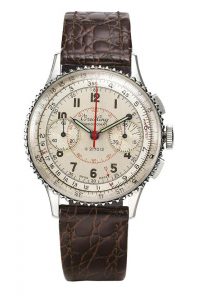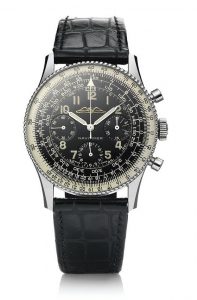Launched in 1941, the Breitling Chronomat was based on a patent document that Breitling submitted in 1940: patent number 217012 granted protection for an instrument-style wristwatch with a circular slide rule. This clever system made it quick and relatively easy to perform various measurements and mathematical operations, e.g., the conversion of speeds or distances from one unit of measurement to another, multiplication, division, and cross-multiplication. This new timepiece attracted many aficionados in sports and industry, and technicians appreciated its special features, which made their work easier. Later versions of the Breitling Replica Chronomat with different cases and dials were the earliest ancestors of Breitling’s legendary Navitimer. The watch shown here contains Venus Caliber 175. A special feature of this watch is a counter for 45 elapsed minutes – a detail welcomed by soccer fans.
Don’t be misled: this watch’s name, which was trademarked in 1955, has nothing to do with the navy. The Breitling Navitimer, which debuted in 1952, was designed to help pilots coordinate time and navigation: it was equipped with calculating functions. Advertisements described this multifunctional device, which contained the hand-wound Breitling Swiss Replica Caliber Venus 178, as a “personal onboard instrument.” The built-in slide rule enabled aviators to multiply and divide, convert nautical miles to land miles, and calculate averages, fuel consumption, average gain of altitude, and distances during ascent and landing. Fumbling with paper and pencil while in flight could be at least partially eliminated. Since it was introduced, the Navitimer has undergone various changes, mainly to its case and the calibers it housed, i.e., hand-wound, hand-wound with date, or self-winding, but no one has ever tampered with its most distinctive feature: its circular slide rule.

Sales of chronographs declined markedly during the second half of the 1960s. Cheap Breitling Replica and its competitor Heuer formed a partnership to develop the first automatic chronograph and hoped that its launch would help counteract the downturn. The adventure began in 1965, when the two firms, along with Büren Watch and Dubois Dépraz, signed a contract to develop the watch; they called the venture Project 99. Büren was taken on as movement supplier because of its experience with micro-rotors. No other type of self-winding caliber could permit the rearward and thus service-friendly installation of the specially developed chronograph module because the small oscillating weight didn’t interfere with the two arbors of the elapsed-time counters. Furthermore, the date ring was positioned directly under the dial. Modular architecture also made it possible to install the crown on the left side, where it clearly showed that this was a self-winding watch. Breitling and Heuer (now TAG Heuer) were responsible for the design, the dials, the cases and the other components. The first prototypes of Caliber 11, which ran at 19,800 vph, were available in the spring of 1968. The official launch of the Best Replica Breitling, the world’s first automatic chronograph with micro-rotor, took place simultaneously in Geneva and New York on March 3, 1969. When the curtains rose, the project had already consumed about half a million Swiss francs.
